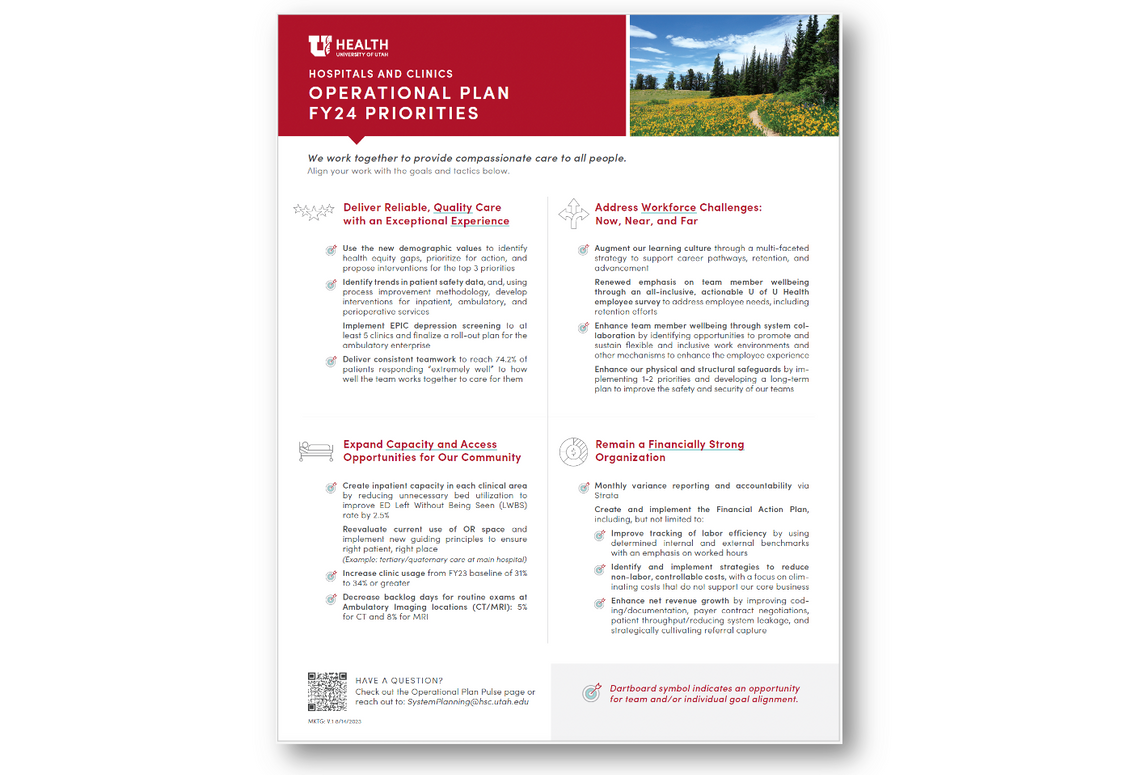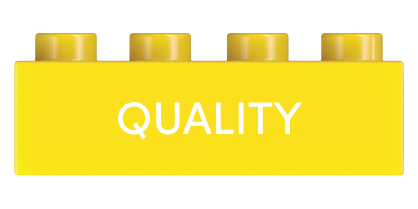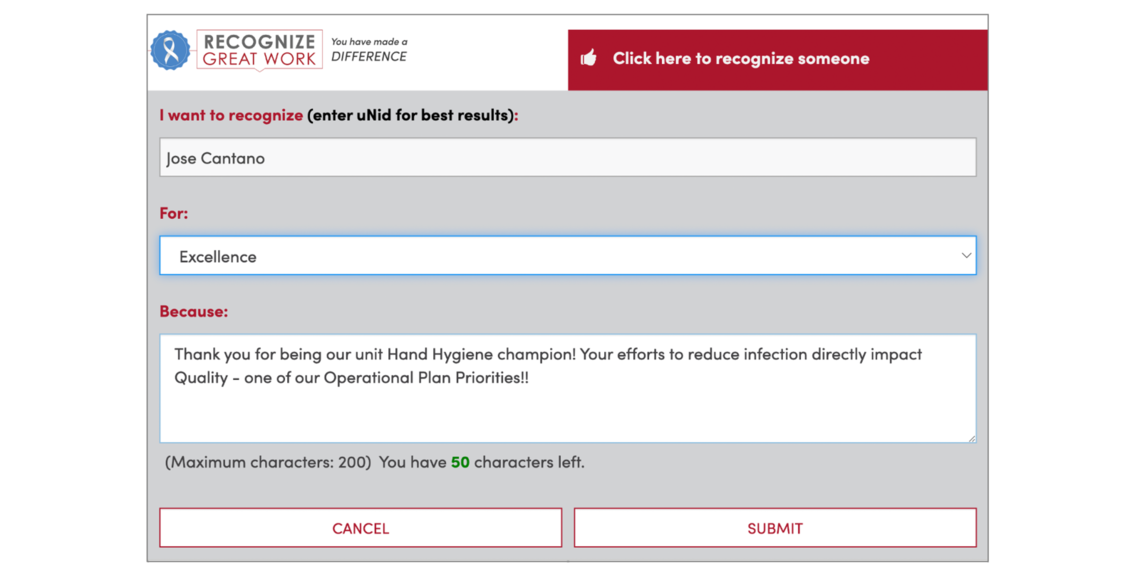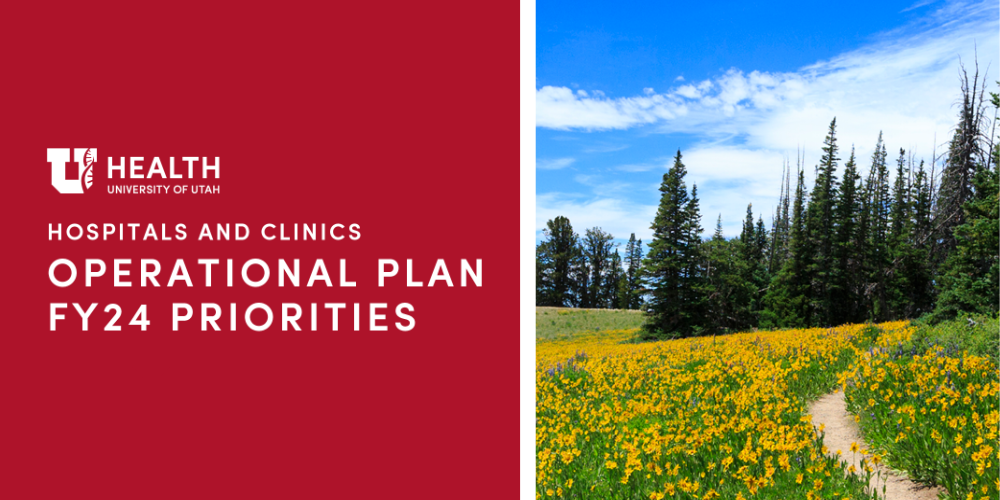UUHC Operational Plan
Fiscal Year 2024 Operational Plan resources available here on Pulse.
ow do 20,000 people provide compassionate care to over 2 million patients every year? At University of Utah Health Hospitals and Clinics (UUHC), we use an Operational Plan to guide us.
The Operational Plan is an annual blueprint that identifies four key priorities for all five hospitals and twelve community clinics in support of University of Utah Health’s broader organizational strategy.
Each of us plays an essential role in the success of this work. Many teams already use the Operational Plan to draft annual goals. For those who are new to the process, here are five ways to contribute to the Operational Plan.
1. Spread the Word
One of the most significant impacts you can make on the Operational Plan is simply to talk about it. Many of our colleagues are new. It might be as simple as asking, “Have you heard of the Operational Plan?”
Here are a few resources to help communicate:
- Share the Operational Plan Pulse Page
- Discuss at staff meetings. Our Leadership Talking Points page and PowerPoint Template for Leaders are great resources for you to talk with your teams about the Operational Plan.
- Print the Operational Plan and hang it up in your workspace
If you lead a team, this is a great opportunity to help explain how your team’s great work fits into the bigger picture. For example, your weekly patient experience comments often reflect glowing praise that defines what exceptional care means to patients and families in their own words. Sharing patient feedback is great way to show how we’re achieving “Exceptional Experience” as a team and organization.
2. Align Team and Individual Goals
Each year we set individual and team goals as part of our annual performance evaluation process. Many leaders align local goals with Operational Plan priorities as a best practice. As a result, these goals align team members' efforts with the broader vision and mission. You can find goal alignment opportunities where there is a Dartboard Symbol on the Operational Plan. For more information about FY24 goal setting, see instructions from HR at the FY24 Goals Pulse Page.

3. Identify KPIs that Support Our Priorities
What is a KPI?
Key Performance Indicators (KPIs) are the most important measurable indicators of progress toward the desired result. It’s how we know what we’re doing is working (or not).
There are many ways that our teams track Key Performance Indicators (KPIs) to measure success, including dashboards, Vizient scores, patient experience comments, and team survey results.
Tracking KPIs is important to understand whether we are meeting our goals and if there are opportunities for improvement. Which KPIs do you track that align and support the Operational Plan? Is there an opportunity to track new KPIs related to the Operational Plan? See the table below for examples of KPIs that relate to our Operational Plan’s priorities:
Much like a LEGO® approach, every individual within the organization contributes their unique piece (work), that when connected with each other at the right time, results in remarkable impact to our patients.
| Operational Priority | KPI Examples |
|---|---|
 |
# Job Openings, Retention Rates, WellCheck Data %, Turnover |
 |
Length of Stay, Space Utilization, Time to Schedule |
 |
Vizient Scores, Infection Rates, Mortality Rates |
 |
Staff Works Together, Scheduling, Explaining, Nurse Leader Rounding |
 |
Labor Efficiency, Charge Capture, Operating Margin, Revenue |
4. Recognize Great Work
As the year progresses, we want to engage and celebrate contributions to the Operational Plan. A simple way to do this is to utilize the Recognize Great Work link on Pulse.
Simply enter the person you are recognizing, describe their contribution to the Operational Plan, and click Submit!

5. Send Us Your Thoughts
One of the best things about U of U Health is the amazing insights from local teams that help improve our work every day. We (System Planning) welcome your feedback as you integrate the Operational Plan into your work, and we always want to hear from you: How can we make it better? What changes would you like to see for the next fiscal year? What questions do you have?
Remember, we’re part of your team too
We know that organizational priorities can feel overwhelming. That’s why we’re here to help if you need it. Simply email System Planning to request a team member come discuss the Operational Plan with your team.
Whether you utilize one of these options or contribute in your own way, together, we can make positive impacts on our employees, patients, and community.
Cassandra Taft
Patients will ask three things of us over the next decade of health care improvement: help me live my best life, make being a patient easier, and make care affordable. To meet those needs health care must shift—from organizing around a patient’s biology to understanding the patient’s biography.
Former Chief Quality Officer Sandi Gulbransen and Accreditation Manager Kemper Funk explain how this umbrella of standards—ISO-9001—relates to our accreditation process and impacts our daily work.
Urogynecology specialist Whitney Hendrickson-Cahill details the steps an interdisciplinary team followed to reduce surgical site infections (SSIs) following hysterectomy procedures, aiming to improve patient outcomes, shorten recovery times, and reduce healthcare costs at University of Utah Health.
